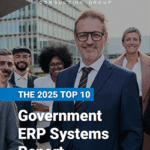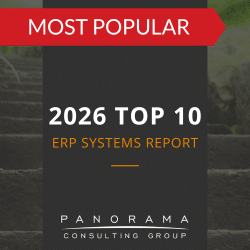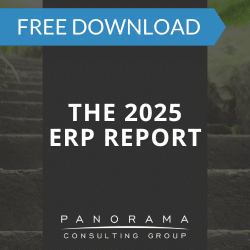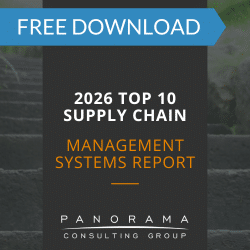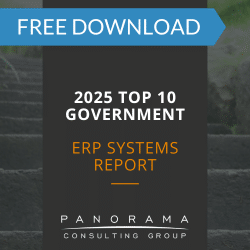- ERP strategy alignment ensures your system reflects business goals, not legacy processes or individual preferences.
- ERP business alignment requires cross-functional input to define workflows that support strategic goals.
- To define ERP requirements effectively, start by identifying the operational changes your strategy depends on.
- Testing ERP requirements against real business scenarios helps ensure they support future growth and adaptability.
As companies increasingly invest in ERP software, the question of business alignment should take center stage.
Too many implementations are built around features rather than strategy. When strategic clarity is missing, even the best ERP software won’t deliver the expected operational or financial returns.
Achieving ERP business alignment requires you to take strategy from the boardroom into the ERP planning trenches. CEOs must define what success looks like operationally and ensure those priorities are embedded into every workflow, role, and reporting structure.
Today, we’re exploring how to define ERP requirements that reflect business priorities and can scale as your organization grows or shifts direction.
The 2026 Top 10 ERP Systems Report
What vendors are you considering for your ERP implementation? This list is a helpful starting point.
How to Define ERP Requirements That Reflect Your Strategy
Too often, companies design systems around current processes or individual preferences instead of enterprise priorities.
This misalignment tends to begin long before implementation. It starts when strategic goals are handed off to technical teams without context; when enterprise-wide objectives are reduced to siloed feature lists; and when operational teams are asked to provide input without understanding broader business goals.
Here’s what our ERP implementation consultants typically recommend when it comes to ensuring ERP strategy alignment:
1. Make Requirements a Co-Design Exercise
The most accurate requirements come from facilitated collaboration.
Avoid creating a linear handoff between strategy and configuration. Instead, bring together business leads, process owners, and solution architects in working sessions.
This approach has two main advantages:
- It reduces the risk of misinterpretation and helps stakeholders see the implications of their input.
- It ensures that technical teams don’t have to guess at business priorities when shaping the system.
For instance, a food and beverage company might hold a joint working session with supply chain managers, plant supervisors, procurement, and IT to map out the entire replenishment process. This would reveal where quality checks are bypassed, where data isn’t shared in real time, and where teams rely on spreadsheets.
Without cross-functional input, these process gaps would likely remain hidden until after go-live.
2. Organize by Capabilities, Not Departments
Your customer satisfaction, financial performance, and supply chain efficiency all depend on how effectively your business units work together during ERP planning.
Rather than collecting ERP requirements by department, map them to capabilities, like lead-to-quote or quote-to-cash. This makes interdependencies visible and allows you to design workflows that reflect how the business actually delivers value.
For example, if a manufacturing company gathers requirements separately by department, it might end up with redundant procurement actions that drive up material costs or a production plan that aligns with plant capacity but misfires on actual demand.
3. Separate Operational Constraints from True Business Needs
Many organizations document requirements that reflect workarounds and inefficient processes. These often appear as “must-haves” during early planning, but once you dig in, you find they don’t actually support long-term business goals.
Ask: Is this a business need, or a habit we built around a previous constraint? Digging into that distinction helps your team avoid rebuilding broken processes in a shinier package.
Our ERP selection consultants often advise clients to assess each requirement using two filters:
- What measurable business outcome does this support?
- How difficult or expensive will this be to implement?
For example, if a requirement aligns with strategic goals, like faster financial close across regions or reliable inventory insights for sales, it likely belongs in your scope. However, if it lacks clear strategic value and demands significant customization, it may be better left out.
4. Test Requirements Against Real Business Scenarios
The following tools can help surface risks that might limit your ability to scale, respond to new demands, or pivot your model:
- Digital whiteboards help you visualize how a customer order flows from sales to fulfillment to finance, and pinpoint where delays, approval gaps, or capacity constraints could slow response times as volume grows.
- Mock interfaces give teams a firsthand look at how they’ll interact with the system when entering orders, approving spend, or handling exceptions. This is critical for identifying friction points that don’t scale.
- Scenario playbacks help you walk through strategic moves like a product launch, market entry, or shift to recurring revenue, and test whether your ERP design enables agility or locks the business into outdated patterns.
For instance, a company expanding into eCommerce might use scenario playbacks to test whether its supply chain system can support more frequent orders, direct-to-consumer shipping, and real-time inventory updates across multiple fulfillment centers.
Design What You Want to Become
ERP alignment is built into the earliest stages of planning—where business goals are translated into operational priorities.
If the planning process is rushed or if it’s owned by the wrong people, you might end up with a system that reinforces outdated workflows, overlooks key reporting needs, and impedes scalability.
However, if the process is grounded in cross-functional design and guided by independent ERP consultants, you will have actionable requirements that reflect your business strategy. Contact our impartial consultants below to learn how we can help you define ERP requirements.


